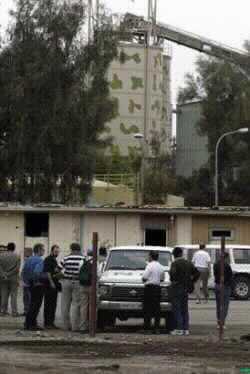U.N. Monitors Revisit Well-Known Sites
29/11/2002| IslamWeb
 The U.N. weapons hunters, sweeping through a disused bio-warfare installation Thursday, spotted a disconnected refrigerator. They moved in, threw open the door, and recoiled in disgust. The stench that wafted out may have come from a batch of harmless material left from a long-ago veterinary experiment. But it got the full treatment - a swab, a sample, analysis to come - in the second day of the painstaking U.N. search for any Iraqi doomsday arms.
The U.N. weapons hunters, sweeping through a disused bio-warfare installation Thursday, spotted a disconnected refrigerator. They moved in, threw open the door, and recoiled in disgust. The stench that wafted out may have come from a batch of harmless material left from a long-ago veterinary experiment. But it got the full treatment - a swab, a sample, analysis to come - in the second day of the painstaking U.N. search for any Iraqi doomsday arms.
After a four-year break, the international experts revisited two sites from Iraq's old weapons programs: a high-tech machining operation that could be key to any nuclear bomb-building, and a veterinary vaccine plant where deadly biological weapons were concocted a decade ago.
They found open doors. "It is very good cooperation," the director of the al-Dawrah vaccine plant told reporters afterward.
The lead inspectors seemed to agree. "It's a good start for the inspections," said Jacques Baute, team leader for the nuclear experts.
The work the inspectors do in the weeks and months to come - to eliminate any Iraqi weapons of mass destruction, or at least to reduce the possibility of them - must be convincing enough to avert a U.S. call for international military action to disarm the Baghdad government. From Iraq's point of view, the inspections must be good enough to persuade the Security Council to lift the U.N. economic sanctions crippling its economy.
But first the arms monitors must make a dent in a list of hundreds of sites potentially connected with programs to produce chemical, biological or nuclear weapons. They have begun by returning to important facilities surveyed and "neutralized" by U.N. inspectors in the 1990s.
The experts believe Iraq may retain some weapons, including some of the tons of botulinum toxin - a deadly biological agent - produced at al-Dawrah before the Gulf War. This is "part of what we call unresolved issues," Demetrius Perricos, in command of the chemical-biological inspectors in Iraq, told reporters.
Earlier Thursday, Perricos' team arrived unannounced at the Foot and Mouth Disease Vaccine Production Laboratory in this town on Baghdad's southern outskirts.
The inspectors gained immediate entry and quickly walked the grounds, as journalists watched from beyond the perimeter fence.
The U.N. team knew where to go based on data from the 1990s, when inspections led to the systematic destruction in 1996 of al-Dawrah equipment instrumental to production of biological weapons agents. The Iraqis had eventually acknowledged making the botulinum, which kills through paralysis and suffocation. The earlier U.N. teams also reported detecting anthrax spores at the site.
On Thursday, the clipboard-toting specialists appeared to check off items as they looked over tanks, pipes and other fixtures. One jeans-clad expert climbed up the side of a 20-foot- high tank, peered over the top, and nodded to a colleague as if to confirm previous information. They took swab samples from air filters and elsewhere.
The Iraqis say the complex has been idle since 1996. When the inspectors left after four hours, the Iraqis opened the gates to the waiting journalists, who found the rooms of the main lab building strewn with wrecked equipment, discarded files and dust-covered boxes of books on veterinary medicine and agricultural science.
They also found caretaker Dr. Karima Niaama inside the main building. Niaama, a veterinarian, said she had led inspectors to areas they inquired about, and it was she who recounted the story of the evil-smelling refrigerator.
Perricos later confirmed the complex "is not in operation, or at least looks like it is not in operation." The visit was part of the inspectors' "rebaselining," fixing the location of sensitive equipment to enable routine monitoring later.
Nuclear inspectors from the Vienna-based International Atomic Energy Agency (IAEA) did the same thing Thursday at a complex of the government's al-Nasr company, 30 miles north of Baghdad, where they checked on sophisticated machine tools that can, for example, help manufacture gas centrifuges. Such centrifuges are used to "enrich" uranium to bomb-grade level - a method favored by the Iraqis in their bomb program of the late 1980s.
Both Perricos and the IAEA's Baute said they were satisfied that all sensitive equipment from both sites had been accounted for.
PHOTO CAPTION
U.N. weapons inspectors prepare to work inside the al-Nasr factory some 50 km (30 miles) north of Baghdad on Thursday, Nov. 28, 2002. UN weapons inspectors for a second day visited sites in Baghdad looking for weapons of mass destruction. (AP Photo/Jassim Mohammed
www.islamweb.net
